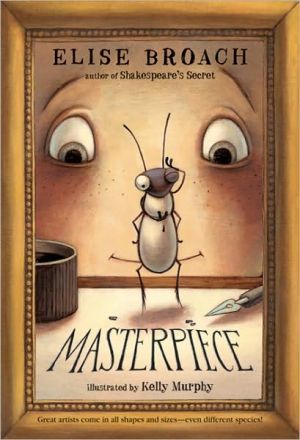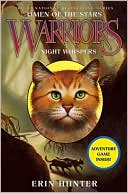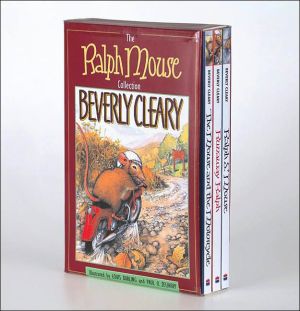Masterpiece
Marvin lives with his family under the kitchen sink in the Pompadays’ apartment. He is very much a beetle. James Pompaday lives with his family in New York City. He is very much an eleven-year-old boy.After James gets a pen-and-ink set for his birthday, Marvin surprises him by creating an elaborate miniature drawing. James gets all the credit for the picture and before these unlikely friends know it they are caught up in a staged art heist at the Metropolitan Museum of Art that could help...
Search in google:
In this fast-paced mystery, eleven-year-old James and Marvin the beetle get caught up in a staged art heist at the Metropolitan Museum of Art. Publishers WeeklyWith overtones of Chasing Vermeer and The Borrowers, this inventive mystery involves two families that inhabit the same Manhattan apartment: the Pompadays-a slick, materialistic couple, their infant son and thoughtful James, from the wife's previous marriage-and a family of beetles, who live behind the kitchen sink and watch sympathetically as James's charms go unappreciated. Careful though the beetles are to stay hidden, boy beetle Marvin crosses the line, tempted by a pen-and-ink set James receives for his 11th birthday. Marvin draws an intricate picture and then identifies himself to a delighted James as the artist. Before James can hide Marvin's picture, Mrs. Pompaday loudly proclaims her son's talent and even James's laid-back artist dad compares the work with the drawings of Albrecht Dürer. A trip to a Dürer exhibit at the Metropolitan Museum of Art follows, James stowing Marvin in a pocket; before long a curator is asking James to forge a Dürer miniature of Fortitude as part of an elaborate plan to catch an art thief (can a tiny virtue defeat big lies?). Broach (Shakespeare's Secret) packs this fast-moving story with perennially seductive themes: hidden lives and secret friendships, miniature worlds lost to disbelievers. Philosophy pokes through, as does art appreciation (one curator loves Dürer for "his faith that beauty reveals itself, layer upon layer, in the smallest moments"), but never at the expense of plot. In her remarkable ability to join detail with action, Broach is joined by Murphy (Hush, Little Dragon), who animates the writing with an abundance of b&w drawings. Loosely implying rather than imitating theOld Masters they reference, the finely hatched drawings depict the settings realistically and the characters, especially the beetles, with joyful comic license. This smart marriage of style and content bridges the gap between the contemporary beat of the illustrations and Renaissance art. Broach and Kelly show readers something new, and, as Marvin says, "When you [see] different parts of the world, you [see] different parts of yourself." Ages 8-13. (Sept.)Copyright © Reed Business Information, a division of Reed Elsevier Inc. All rights reserved.
\ CHAPTER 4: A Present for James The journey through the dark apartment to James’s room was an arduous one. Rolling the nickel across the kitchen tile went relatively smoothly, but hoisting it over the door sills left Marvin exhausted and panting. He had to watch for trouble every step of the way, not just night-roving Pompadays, but the booby-traps of forgotten gum or scotch tape on the floor, or worse yet, a foraging mouse.\ When he finally reached James’s bedroom, he had to sit for a minute to catch his breath. A streetlamp outside the window cast dim light across the walls, and in the bluish blackness, Marvin saw the mountainous silhouette of James, asleep under the blankets. He heard the boy’s deep breaths.\ Marvin thought about the birthday party. Had it been a good day for James? The boys at the party weren’t his friends. The presents had been an uninspired mix of electronic games and designer clothing. Mrs. Pompaday was as fussy and self-centered as always, and even James’s father, whom Marvin liked a lot, hadn’t come up with a present that seemed to please his son. Marvin glanced down at the worn face of the buffalo nickel. Would the coin make up for everything else? Probably not.\ Suddenly, Marvin felt so sad he could hardly stand it. A person’s birthday should be a special day, a wonderful day, a day of pure celebration for the luck of being born! And James’s birthday had been miserable.\ Marvin rolled the nickel to a prominent place in the middle of the floor, away from the edge of the rug where it might be overlooked. James would see it here. He looked around the dark room one last time.\ Then he saw the bottle of ink. It was high up on James’s desk, and it appeared to be open.\ Curious, Marvin crawled across the floor to the desk and quickly climbed to the top. James had spread newspaper over the desk, and two or three sheets of the art paper his father had given him. On one page he’d made some experimental scribbles and had written his name. The pen, neatly capped, rested at the edge of the paper, but the bottle of ink stood open, glinting in the lamplight.\ Without really thinking about what he was doing, Marvin crawled to the bottle cap and dipped his two front legs in the ink that had pooled inside. On his clean hind legs, he backed over to the unused sheet of paper. He looked out the window at the nightscape of the street: the brownstone opposite with its rows of darkened windows, the snow-dusted rooftop, the streetlamp, the naked, spidery branches of a single tree. Gently, delicately, and with immense concentration, Marvin lowered his front legs and began to draw.\ The ink flowed smoothly off his legs across the page. Though he’d never done anything like this before, it seemed completely natural, even unstoppable. He kept glancing up, tracing the details of the scene with his eyes, then transferring them onto the paper. It was as if his legs had been waiting all their lives for this ink, this page, this lamp-lit window view. There was no way to describe the feeling. It thrilled Marvin to his very core.\ He drew and drew, losing all sense of time. He moved back and forth between the bottle cap and the paper, dipping his front legs gently in the puddle of black ink, always careful not to smear his previous work. He watched the picture take shape before his eyes. It was a complicated thatching of lines and whirls that looked like an abstract design up close, as Marvin leaned over it. But as he backed away, it transformed into a meticulous portrait of the city-scape: a tiny, detailed replica of the winter scene outside the window.\ And then the light changed. The sky turned from black to dark blue to gray, the streetlamp shut off, and James’s room was filled with the noise of the city waking. A garbage truck groaned and banged as it passed on the street below. James stirred beneath his bedcovers. Marvin, desperate to finish his picture before the boy awakened, hurried between the page and the bottle cap, which was almost out of ink. At last he stopped, surveying his miniature scene.\ It was finished.\ It was perfect.\ It was breathtaking.\ Marvin’s heart swelled. He felt that he had never done anything so fine or important in his entire life. He wiped his ink-soaked forelegs on the newspapers and scurried behind the desk lamp, bursting with pride, in a fever of anticipation, just as James threw off his blankets.\ James stumbled out of bed and stood in the center of the bedroom, rubbing his face. He looked around groggily, then straightened, his eyes lighting on the floor.\ “Hey,” he said softly. He padded over to the nickel and crouched, picking it up.\ Good for James, thought Marvin. Of course there was no reason to worry that he’d overlook it.\ James turned the coin over in his palm and smiled. “Huh,” he said, walking toward his desk. “I wonder where this came from.”\ Marvin stiffened and retreated further behind the desk lamp.\ James gasped.\ Marvin watched his pale face, his eyes huge, as he stared at the drawing. He quickly looked behind him, as if the room might hold some clue that would explain what he saw on the desk.\ Then slowly, brows furrowed, James pulled out the chair and sat down. He leaned over the picture. “Wow,” he said. “Wow!”\ Marvin straightened with pride.\ James kept examining the drawing, then the scene through the window, whispering to himself. “It’s exactly what’s outside! It’s like a teeny, tiny picture of the street! This is amazing.”\ Marvin crept around the base of the lamp so he could hear the boy better.\ “But how . . . ?” James picked up the pen and uncapped it, squinting. He lifted the bottle of ink and frowned, screwing the bottle cap back on. “Who did this?” he asked, staring again at the picture.\ And then, without planning to—without meaning to, without ever thinking for a moment of the consequences—Marvin found himself crawling out into the open, across the vast desk top, directly in front of James. He stopped at the edge of the picture and waited, unable to breathe.\ James stared at him.\ After a long, interminable silence, during which Marvin almost dashed to the grooved safety of the wainscoting behind the desk, James spoke.\ “It was you, wasn’t it?” he said.\ Marvin waited.\ “But how . . . ?”\ Marvin hesitated. He crawled over to the bottle of ink.\ James reached across the desk and Marvin cringed as enormous pinkish fingers swept tremblingly close to his shell. But the boy avoided him, carefully lifting the bottle and shaking it. He unscrewed the cap and set it down next to Marvin.\ “Show me,” he whispered.\ Marvin dipped his two front legs in the ink cap and walked across the page to his picture. Unwilling to change the details of the image, he merely traced the line that framed it, then stepped back.\ “With your legs? Like that? Dipping them in the ink?” A wide grin full of wonderment and delight spread across James’s face. “You really did that! A bug! That’s the most incredible thing I ever, ever, ever saw in my whole entire life!”\ Marvin beamed up at him.\ “And with my birthday present too! You couldn’t have done it without my birthday present.” His voice rose excitedly, as he leaned closer to Marvin, his warm breath almost blasting Marvin over.\ “It’s like we’re a team. And you know what? I didn’t even want this birthday present before. I thought, ‘What am I going to do with this, I’m not like my dad, I don’t even know how to draw.’ But now, it’s the best gift I ever got. This birthday is the best one ever!”\ Marvin smiled happily. He realized that James could not for one minute see his expression, but he suspected somehow that the boy knew anyway.\ Just then, they heard a noise in the hallway and Mrs. Pompaday’s voice: “James, what are you doing in there? Who are you talking to?”\ Marvin dove for cover, squeezing under James’s china piggybank at the exact moment that Mrs. Pompaday swept into the room. Excerpted from MASTERPIECE by Elise Broach.\ Copyright © 2008 by Elise Broach.\ Published in 2010 by Square Fish.\ All rights reserved. This work is protected under copyright laws and reproduction is strictly prohibited. Permission to reproduce the material in any manner or medium must be secured from the Publisher.
\ From the Publisher\ "Inventive ... Broach ... packs this fast-moving story with perennially seductive themes: hidden lives and secret friendships, miniature worlds lost to disbelievers ... Broach and Kelly show readers something new."\ --Publishers Weekly (Starred Review) "Delightful intricacies of beetle life ... blend seamlessly with the suspenseful caper as well as the sentimental story of a complicated-but-rewarding friendship ... Murphy’s charming pen-and-ink drawings populate the short chapters of this funny, winsome novel."\ --Kirkus Reviews "This marvelous story is sure to be a hit."\ --School Library Journal\ \ \ \ \ Publishers WeeklyWith overtones of Chasing Vermeer and The Borrowers, this inventive mystery involves two families that inhabit the same Manhattan apartment: the Pompadays-a slick, materialistic couple, their infant son and thoughtful James, from the wife's previous marriage-and a family of beetles, who live behind the kitchen sink and watch sympathetically as James's charms go unappreciated. Careful though the beetles are to stay hidden, boy beetle Marvin crosses the line, tempted by a pen-and-ink set James receives for his 11th birthday. Marvin draws an intricate picture and then identifies himself to a delighted James as the artist. Before James can hide Marvin's picture, Mrs. Pompaday loudly proclaims her son's talent and even James's laid-back artist dad compares the work with the drawings of Albrecht Dürer. A trip to a Dürer exhibit at the Metropolitan Museum of Art follows, James stowing Marvin in a pocket; before long a curator is asking James to forge a Dürer miniature of Fortitude as part of an elaborate plan to catch an art thief (can a tiny virtue defeat big lies?).\ Broach (Shakespeare's Secret) packs this fast-moving story with perennially seductive themes: hidden lives and secret friendships, miniature worlds lost to disbelievers. Philosophy pokes through, as does art appreciation (one curator loves Dürer for "his faith that beauty reveals itself, layer upon layer, in the smallest moments"), but never at the expense of plot. In her remarkable ability to join detail with action, Broach is joined by Murphy (Hush, Little Dragon), who animates the writing with an abundance of b&w drawings. Loosely implying rather than imitating theOld Masters they reference, the finely hatched drawings depict the settings realistically and the characters, especially the beetles, with joyful comic license. This smart marriage of style and content bridges the gap between the contemporary beat of the illustrations and Renaissance art. Broach and Kelly show readers something new, and, as Marvin says, "When you [see] different parts of the world, you [see] different parts of yourself." Ages 8-13. (Sept.)\ Copyright © Reed Business Information, a division of Reed Elsevier Inc. All rights reserved.\ \ \ KLIATT\ - Janis Flint-Ferguson\ Although some readers may be put off by a story about a beetle and a boy, this is a great mystery for young adolescents. The main character is Marvin, a beetle who lives with his family inside the home of James, his mother, stepfather and baby brother. On James's birthday, his biological father, an artist, gives him an ink set. Marvin, though, is the one who has artistic talent and he uses James's pens to draw a tiny miniature as a gift to the 11-year-old. James's father is thrilled that "his son" seems to have followed in his artistic footsteps and takes James on a trip to the art museum to see famous miniatures drawn by Albrecht Durer. Through a series of coincidences, James and Marvin are introduced to the world of stolen artwork and it will take all of their ingenuity to return the art and capture the thief, while covering up the fact that it is not James who draws, but the little black beetle. Marvin is a great little character, with much curiosity and talent. He and his family live off the crumbs and scraps left behind in the house. James is a quiet boy caught in a divorce and trying to find his own identity. He doesn't know how to explain the prized miniature that thrusts him into his mother's spotlight. The friendship between the two characters is believable and is a major theme as the two seek to help and support one another. Reviewer: Janis Flint-Ferguson\ \ \ \ \ Children's Literature\ - Sharon Oliver\ Broach, with two successful juvenile novels behind her, presents a third sure hit with mystery readers. Marvin is a beetle who lives with his family under the kitchen sink of the Pompaday family, Mrs. Pompaday, her son James, his little brother, and his stepfather, Mr. Pompaday. When James receives a drawing kit from his artist father on his birthday, Marvin sneaks in for a closer look and discovers he has a talent for drawing. When the adults think James is responsible for the remarkable drawing, he gets caught up in a plan to fake a famous Albrecht Durer drawing in an elaborate plot to catch a thief. Unfortunately, things go awry and the real drawing is stolen instead. Marvin manages to stay with the painting and tries to get back to his friend James to recover the famous artwork. Aside from a couple of wandering sub plots, this is a great mystery and a rousing adventure. Through it all, James and Marvin learn quite a bit about art, people, and taking credit for work that is not your own. This is a wonderful addition to juvenile fiction collections and is sure to be hit with fans of Broach's previous novels as well as new readers. Reviewer: Sharon Oliver\ \ \ \ \ School Library JournalGr 5-8\ Elise Broach's novel (Holt, 2008) is the story of a beetle named Marvin who lives under the kitchen sink in a New York City apartment, and his friendship with James Pompaday, a human boy. Marvin feels sorry for James, whose mother never seems to have anything nice to say about him. After an unpleasant 11th birthday party, Marvin decides to do something nice for James. He uses the ink from a pen-and-ink set that the boy received for his birthday to draw a miniature of the scene outside of the boy's bedroom window. Mrs. Pompaday sees the drawing and thinks her son is the artist. Soon James finds himself being compared to Albrecht Durer, the famous Renaissance artist, and becomes involved in a plot to help the Metropolitan Museum of Art recover several Durer masterpieces that have been stolen. Jeremy Davidson skillfully portrays the various characters, easily transitioning between their voices. This marvelous story is sure to be a hit with middle school students.-Kathy Miller, Baldwin Junior High School, Baldwin City, KS\ \ \ \ \ \ Kirkus ReviewsEleven-year-old James Terik isn't particularly appreciated in the Pompaday household. Marvin, a beetle who lives happily with his "smothering, overinvolved relatives" behind the Pompadays' kitchen sink, has observed James closely and knows he's something special even if the boy's mother and stepfather don't. Insect and human worlds collide when Marvin uses his front legs to draw a magnificent pen-and-ink miniature for James's birthday. James is thrilled with his tiny new friend, but is horrified when his mother sees the beetle's drawing and instantly wants to exploit her suddenly special son's newfound talents. The web further tangles when the Metropolitan Museum of Art enlists James to help catch a thief by forging a miniature in the style of Renaissance artist Albrecht Durer. Delightful intricacies of beetle life-a cottonball bed, playing horseshoes with staples and toothpicks-blend seamlessly with the suspenseful caper as well as the sentimental story of a complicated-but-rewarding friendship that requires a great deal of frantic leg-wiggling on Marvin's part. Murphy's charming pen-and-ink drawings populate the short chapters of this funny, winsome novel. (author's note) (Fantasy. 10-14)\ \








